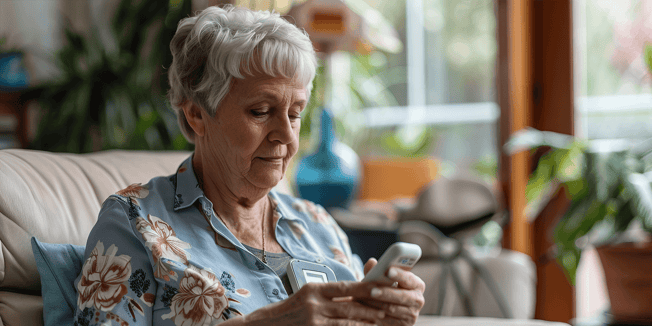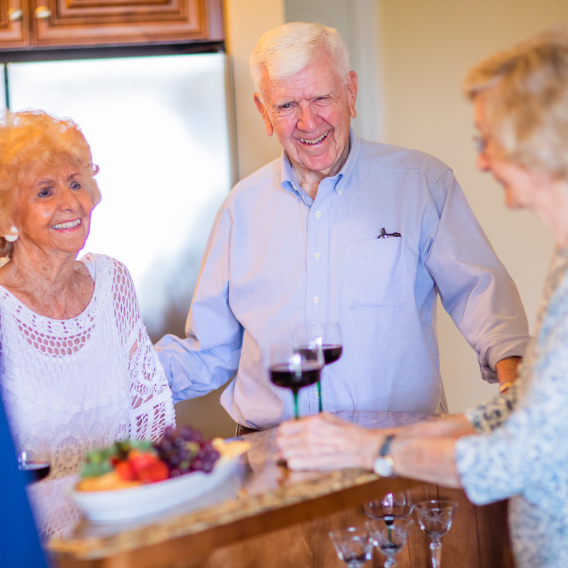Medical Alert Systems: What Works, What Doesn’t, and Who Needs One?
Listen to this article

As you get older, safety is probably on your mind more often—maybe even daily. Changes in your physical wellness and general health make it natural to wonder, “What would I do in an emergency? How would I get help?”
In situations such as a fall, heart attack, or stroke, every second counts. Medical professionals refer to this critical window as the “golden hour,” the first 60 minutes when timely treatment provides a greater likelihood of recovery. One tool families turn to for peace of mind is a medical alert system, a wearable device designed to call for help. These systems provide reassurance, but are they the right fit for your situation?
As you navigate the aging journey, it’s worth taking an honest look at the pros and cons of a medical alert system, from the features they offer to the ways they fall short and alternatives that may provide more security.
In this guide, we'll discuss:
- What is a medical alert system, and how does it work?
- What medical alert system options are available?
- WHO CAN BENEFIT FROM A MEDICAL ALERT SYSTEM?
- Is a medical alert system or assisted living best for me?
- How do I make the right choice?
What is a medical alert system, and how does it work?
A medical alert system provides you with access to medical help when you need it, supports your independence, and reduces the time it takes to get care during a crisis. These systems also provide family members and caregivers with peace of mind, whether they live near or far.
A typical medical alert system has two parts:
- Basic equipment: A base unit or a wearable device that can be worn as a necklace or bracelet, put into a pocket, or worn around a belt loop
- Optional accessories/features: Battery backup, a wall-mounted button, location tracking function, medication reminder alerts, and so on
When you press the alert button or activate a built-in fall detection signal, one of several options will occur depending on what kind of system you choose. Unmonitored systems will automatically call 911 or a designated caregiver. Monitored systems will connect you to a call center staffed by trained professionals who assess the situation and send the appropriate help, whether it’s emergency services or your closest family member.
What medical alert system options are available?
Medical alert systems have come a long way in the last decade or so, especially in light of new technology developments. Early systems were bulky, less reliable, and restricted to the home environment. Modern medical alert systems are much more dynamic, reliable, and come with a variety of functions and features to choose from.
Monitored vs. Unmonitored
A monitored medical alert system is connected to a center staffed with trained professionals who oversee the emergency calls and assess the situation quickly, connecting to 911 or a list of emergency contacts. Monitored systems include additional monthly charges, but they also offer benefits and services that unmonitored systems don’t. Staff members at monitoring centers go through rigorous training so they understand how to best respond to an emergency.
Unmonitored medical alert systems don’t connect to a central monitoring center. Instead, they automatically connect to an emergency contact or 911. A downside of unmonitored systems is that you may not always need 911 when an incident occurs. In that case, emergency personnel arrive at your home without important contextual information. Additionally, with an unmonitored system, there’s a risk that your emergency contacts will miss the alert notification, leaving you without help for a longer period of time.
In-Home vs. Mobile
In-home equipment includes a base unit in your home that connects to sensors mounted to the wall or a wearable device. With in-home systems, a cellular or landline connection is required to communicate with the monitoring center.
If you choose a mobile system, a base unit usually isn’t installed; instead, this system relies exclusively on a cellular connection. Note that with a cellular connection, you will be using the cellular connection of the medical alert company. Check with the alert monitoring company to find out which cellular provider they use, and choose a system with a provider that has a strong signal in your area. If you live in a place where cellular signal is unreliable, then a mobile system may not be your best option.
Basic System vs. Advanced Features
When choosing a medical alert system, you’ll need to consider whether a basic setup is sufficient or if you would prefer to upgrade to one with advanced safety features. If you prefer simple technology and want a budget-friendly option, a basic system is ideal. If you leave the house regularly, you want to share your location with your family for peace of mind, or if the system is for someone with memory issues who is at risk of wandering, you should consider adding advanced features, such as:
Fall Detection Technology
Fall detection technology can be built into the medical alert system to sense when a fall has occurred. By using accelerometers to measure speed and acceleration, it senses abrupt changes in movement that indicate a sudden drop or impact.
Fall detection features can trigger false alarms. When selecting a device, ask specific questions about the accuracy and sensitivity of the fall detection. You should also understand what exactly happens when a fall is detected and whether the alert can be manually overridden.
GPS Tracking
Medical alert systems with GPS functionality are helpful for everyone, but especially for older adults who are active or who have conditions such as Alzheimer’s or another type of dementia and are at risk of wandering. With built-in location tracking, your exact location can be pinpointed so emergency responders can locate you when necessary. Some systems even allow authorized people to view your location updates through an app. You’ll have peace of mind and a stronger sense of connection no matter how far away your family members are.
Smartwatch-Style Options
If you’re tech-savvy or prefer a discreet medical alert device, a medical alert smartwatch might be the best option. In addition to standard safety monitoring, many of these watches offer additional features, such as:
- Medication reminder alerts
- Heart rate monitoring
- Blood pressure and blood sugar tracking
- Weather notifications
- Step counting
- Voice-to-text communication with family, friends, and caregivers
AI-Supported Options
AI voice assistants are also available to summon help in emergencies, including falls. These subscription services use a voice-activated device to connect to an urgent response agent and automatically notify family contacts of a fall or medical emergency.
Who can benefit from a medical alert system?
When it comes to deciding if you’ll benefit from a medical alert system, functional ability—your capacity to handle regular day-to-day tasks safely—is a key indicator. If you are dealing with any of the following, a medical alert system might be the right resource for you:
- Chronic conditions (diabetes, heart disease, and so on)
- Cognitive decline or memory issues
- A history of falls or mobility issues
- Recent hospitalization or recovery from surgery
- Living alone or being alone for long periods
- Living in a home environment with hazards such as stairs, unsecured rugs, poor lighting, and so on
- Caregivers who would like more peace of mind knowing that you’re safe
The most important factor is whether you’re able and willing to wear the device all the time and keep it charged. The most expensive, elaborate medical alert system won’t provide much benefit if the emergency button is out of reach or out of battery.
Is a medical alert system or assisted living best for me?
The choice between a medical alert system and moving to assisted living comes down to your level of independence, safety needs, and the kind of support you need day to day.
A medical alert system may be best if you’re mostly independent, don’t need help with daily activities such as getting dressed and bathing, and have a caregiving plan in place. A move to assisted living provides comprehensive support for your care needs and resources to enhance your health and well-being, with immediate help available to you 24/7.
Medical alert systems can leave significant safety gaps, so consider these when deciding:
- The system only works if you remember to keep it charged and wear it all the time.
- It can’t monitor your overall quality of life; health and nutrition, medication management, and even loneliness play significant factors in your well-being.
- Although a medical alert system summons help in an emergency, the time for help to arrive will vary based on your location.
Assisted living covers these safety gaps and more. Trained team members are on hand daily to help you with medication management, dressing, and other needs. The community offers a wealth of benefits and support for healthy living, such as delicious dining options that ensure you get the food you need to support healthy aging without the hassle of grocery shopping and cooking.
Assisted living is also designed around socialization opportunities to prevent isolation and loneliness. Shared spaces, such as dining areas, and on-site events, such as art classes and book clubs, can help you make new friends while strengthening existing connections.
One of the biggest benefits of choosing assisted living is your ability to receive immediate medical assistance when needed. Communities are staffed around the clock with specially trained team members who are seconds away in case of a fall or other emergency.
How do I make the right choice?
The choice you make will depend on your health needs, living situation, and peace of mind. More than anything, you want to make a decision that preserves your safety and quality of life.
If you would like to know more about the benefits you can experience in a senior living community, our guide, Understanding Senior Living Lifestyle Options, provides detailed information and answers common questions.
This post was originally published in June 2023 and updated in August 2025.






.png?width=307&height=200&name=Blog%20%2333%201400%20x%20700%20(1).png)

.png?width=307&height=200&name=Blog%20%2332%201400%20x%20700%20(8).png)



